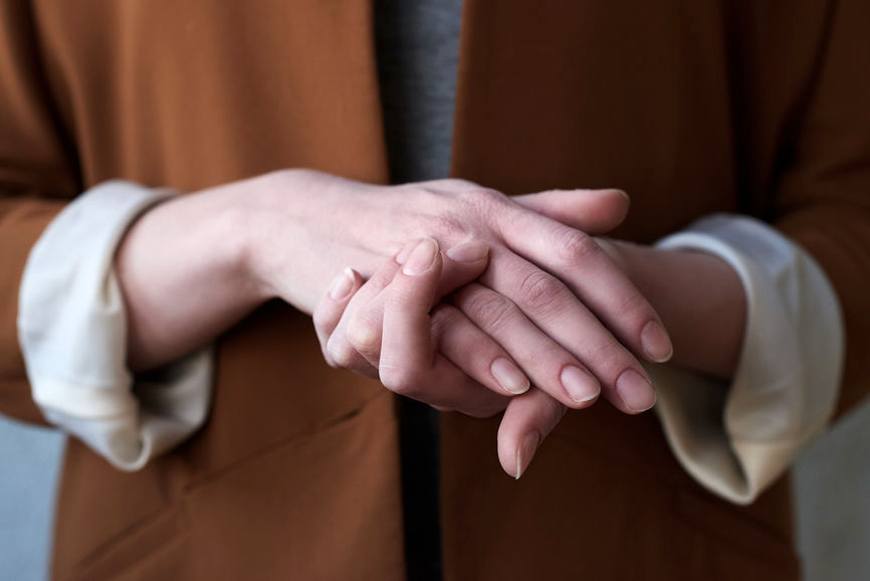Nail biting is a hard habit to have (and an even harder one to break). While you’re filling your mouth with icky bacteria and chipping away at your tooth enamel—not to mention ruining your perfect manicure—you might not even realize that you're doing it. And sure, those nasty-tasting nail lacquers and hypnosis work to nix the bad habit and all, but so too, could mindfulness.
Practicing mindfulness is identifying the triggers that lead us to problematic behavior, including nail biting.
“Mindfulness strategies help us learn to accept what is true for us in the present moment without judging or pushing it away—even if we don’t like what we see,” says Denise Gour, LCSW, of Mindful Place Counseling in Portland, Oregon. Because mindfulness uses elements of self-awareness as well as self-kindness, practicing it can help to identify the triggers that lead us to problematic behavior—including nail biting.
“Look at thoughts, emotions, and body responses to the initial trigger,” Gour explains. When you realize what your triggers are (perhaps work stress or a relationship is causing you to gnaw at your fingernails), you're better able to stop your typical reactions and replace those with more positive behavior.
"We can’t always control the stressors, but we can explore the truth of our perception and appraisal and modify our response accordingly," she says.

How to practice it
One of the ways you can incorporate mindfulness into your bad-habit-busting mindset is to align your senses, explains Brooklyn therapist Keeley Teemsa, MA, MSW, LCSW. For instance, if you’re beginning to zone out or go into autopilot mode, Teemsa suggests you pick a sense and find five different things associated with it for ten seconds each. Say you’re in the shower and your mind's trailing—try using the sense of touch to feel your soap, the bathroom tile, your hair, etc. Then move on to sight, and then sound, and so on. “The more you do that, the harder it is to be in your head,” says Teemsa.

{{post.sponsorText}}
When you’re then able to trace and pinpoint your triggers and then get yourself out of autopilot, Gour says that’s when you can start to use those same tools to stop the nail biting habit.
“It’s like taking a step back and objectively seeing what’s going on,” Gour says. “With that awareness, you're in a better position to respond effectively to the stressor versus indulging in the bad habit. Neuroscience shows that the more frequently we replace the old habitual response with the new one, the stronger the neural connections form to support the desired change." After that, the urges become less frequent and less intense–ultimately diminishing the ol' biting tendency completely.

The physical (and health!) benefits
Once you get the mindfulnesss down pat, you'll reap the gorgeous, mani-ready benefits. This means a more normal shape of the nail, no more white splotches on the nail plate due to trauma, and no risk of black or brown stripes down the nail, which Dana Stern, MD a New York City dermatologist notes are all consequences of nail biting. Factor those in with knowing that your mouth is, as Stern puts it, “a virtual petri dish,” and you’re avoiding opening yourself up to countless germs, including the increased risk of getting sick.
“[Nail biting] can result in the transfer of yeast and bacteria that are normally found in the mouth but should not be on the nails and fingers and can consequently result in infections of the nail such, as Paronychia,” she explains. Yikes.
Stern, who has her nail-biting patients practice “habit reversal” (in which they keep diaries in order to better understand their behavioral patterns and develop a distracting competing response, such as using a stress ball), says that sufferers will see a change and look and feel better when they use their mindfulness techniques to stop the habit. “The nails will begin to grow in normally without surface abnormalities and white spots,” she says. “The cuticle will be healthier and they will not be prone to swelling and redness at the skin surrounding the nail.” Or in other words: Nails on fleek.
These are the supplements to take for your healthiest nails ever. And this is how to perfect the at-home manicure, according to Gwen Stefani's manicurist.
Loading More Posts...